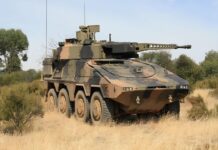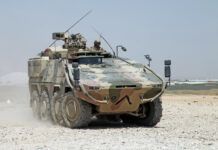At the AUSA Annual Meeting, General Dynamics Landsystems (GDLS) unveiled its Next Generation Electronic Architecture (NGEA), designated KATALYST. The NGEA was presented integrated with a heavy unmanned combat vehicle serving as a demonstrator.
The increasing number of electronic and electrical devices for reconnaissance, communication, fire control, weapon systems and electronic warfare is constantly placing new and higher demands on the management of data and energy flows in combat vehicles. NATO has set a standard for this with the NATO Generic Vehicle Architecture. The KATALYST NGEA is based on the same Modular Open Systems Approach and is designed to meet NATO standards, GDLS said. The company pointed out that the KATALYST architecture offers scaleable and modular hardware and software for next generation capabilities on all future platforms and can serve as a basis for continuous modernisation to optimise performance, size, weight, power and cost.
GDLS explained the concept of KATALYST by analogy with a mobile phone. KATALYST provides the electronic components and the operating system on the basis of which new applications for future capabilities can be implemented at any time with almost unlimited capacity. The hardware includes:
- sensors
- computer processors
- standard I/O interfaces
- Ethernet
- CAN bus data exchange
- crew display
KATALYST is also capable of integrating other vehicle subsystems, such as active protection or defence from UAS, according to the company.
For AUSA 2021, GDLS presented a technology demonstrator with KATALYST architecture showing capability gains in all categories. The company stressed that mobility (obstacle avoidance, path planning), lethality (object detection, object identification/recognition, automatic target prioritisation) and survivability/reconnaissance (360-degree situational awareness, see-through armour, terrain analysis) were significantly improved.
KATALYST Purpose
KATALYST was developed with the OMFV programme in mind, with which the US Army intends to replace the BRADLEY IFV. GDLS has been selected for Phase II of the OMFV programme and is working with the US Army to develop the overall system requirements. In the next phase of the programme next year, the company plans to build an OMFV prototype. Elements of the KATALYST NGEA are already integrated with several US Army and Marine Corps prototype vehicles, GDLS said.












